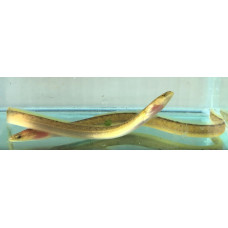Latin name
Anguilla australis
Other name
Shortfin eel
Identification
The body is long, snake-like, tubular, the head is small, and the jaws reach from behind to below the eyes or further back.
Anguillid eels are undifferentiated gonochorists. This means that the sex of the animal is determined by the undifferentiated sex glands. Differentiation then occurs and the eel becomes male or female, and this usually correlates with the size (30 cm) of the animal rather than its age.
Features of fish fins
The dorsal (upper) and anal (lower) fins are about the same length.
Fish colouring
Coloration varies considerably from individual to individual; usually dark olive green, but can be much lighter, golden, or even (rarely) yellowish. There are no conspicuous markings, but the underside is pale, often silvery, and the fins are greenish.
Distribution
Widespread throughout the lowlands of New Zealand, including Chatham and Stewart Island/Rakiura, but generally do not venture far inland. In Australia, they are restricted to the area on the seaward side of the Great Dividing Range, roughly from Mount Gambier in southeastern South Australia, through Victoria, Tasmania, the Bass Strait Islands, and up the east coast to the Richmond River in northern New South Wales. Unable to cross the Great Dividing Range and not extending west to the source of the Murray River, they are cut off from thousands of kilometers of waterways that run deep into eastern Australia.
Habitat
Marine tropical freshwater brackish benthic pelagic species. Depth ranges from 0 to 3,000 meters. Occurs in streams, lakes and swamps.
Size
In adulthood, they reach about 90 centimeters. Females typically grow from 15 to 30 years of age and reach a maximum size of about 1.1 meters and 3 kg. Males tend to grow more slowly and reach smaller sizes as adults. Maximum reported age: 32 years.
Behavior
Short-finned eels are catadromous: when they reach maturity, they stop feeding and migrate downstream to the ocean, then travel up to three to four thousand kilometers to spawn in deep water somewhere in the Coral Sea off the coast of New Caledonia.
These fish are remarkably hardy: they can survive high water temperatures and low oxygen levels, go without food for long periods, burrow into mud or sand, and go into an energy-conserving torpor when water temperatures drop below 10°C (50°F).
Food and feeding habits
Anguilla australis are carnivorous and fierce predators that feed on crustaceans, fish, frogs, birds, snakes and Australian water rats (rakali).
Reproduction
The reproductive biology of these eels during the marine phase remains unclear. Much is known about the longer freshwater phase from juvenile to sexual maturity. This species does not breed outside its Pacific spawning grounds. Leptocephalus ("narrow-headed") larvae drift with ocean currents (off Australia, Southern Equatorial Current) and eventually reach coastal waters where they develop into "glass eels" (tiny, translucent). They are unable to feed at this stage and can only feed when they reach the mouth of a river, where they transform back into elvers, which are darker in color. From there, they migrate upstream, overcoming numerous obstacles and, when necessary, leaving the water to travel short distances on wet ground.
Fishing
Modern recreational anglers regularly catch and eat this eel, and New Zealand has a well-established commercial fishery.
Relationship with a person
Despite its slimy appearance, the flesh of the short-finned eel is of excellent quality and is considered a delicacy in many countries.
| Classification | |
| Phylum | Chordata |
| Class | Actinopterygii |
| Squad | Anguilliformes |
| Family | Anguillidae |
| Genus | Anguilla |
| Species | A. australis |
| Features | |
| Conservation status | Near Threatened |
| Habitat | Pelagic |
| Life span, years | 32 |
| Maximum body weight, kg | 3 |
| Maximum length, cm | 110 |
| Sailing speed, m/s | No information |
| Threat to people | Edible |
| Way of eating | Predator |
Short-finned eel
Tags: short finned eel

